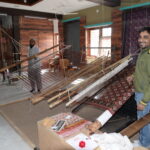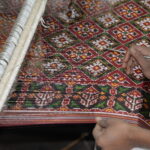
Barbara Setsu Pickett, an Associate Professor Emerita, in the Department of Art at the University of Oregon in Eugene, Oregon, focuses her research and creative practice on velvet weaving, shibori, natural dyeing, and the book arts. Among her awards are a Fulbright Research fellowship, a Rockefeller Bellagio residency, and grants from the National Endowment for the Arts, the Gladys Krieble Delmas fund and Institute of Turkish Studies. She and her son Michael formed the Mihara Shibori Studio in 2005, and they create highly textured silk scarves in distinctive palettes expanding on the Japanese traditional shibori techniques.

The Face-to-Face Velvet Powerloom Makes Inflatable Cloth for Decoy Tanks
Today a Czech firm, InflaTech produces fake armaments that help Ukraine fool the Russian military. They took lessons from Listers, the cutting-edge company in WWII Bradford, England, that invented the revolutionary face-to-face velvet powerloom and modified it to produce Resilitex, a tubular doublecloth that could be imbued with neoprene and inflated and molded into full-size dummy tanks and military trucks. Learn about the birth of this new defense division called Deceptive Textiles and how Churchill convinced Roosevelt to launch the Ghost Army in the USA. Listers’ war efforts were top-secret for decades, but now details are revealed.
This session will be captured for the Weavers Handshake, CW’s online, on-demand learning platform.

The Patola Loom of Patan, India
No loom frame, no shafts with treadles, no beater with reed. See how the patola loom works to create the precise double ikat silk designs of Patan, India. Patolas’ intricate geometric designs are simple plain weave; however, they demand masterful natural dyeing skills to achieve the vivid results of three dyebaths coupled with impeccable weaving skills that exactly align the resist dyed warps and wefts. The loom is suspended, more like the body-tensioning backstrap loom. The two sheds are achieved with a bamboo shed roll and an ingenious heddle rod device. The weft is wound around a shaft and is carried across the open shed in a bamboo casing. The suspended loom is intentionally slanted to create an incline, so gravity helps the heavy batten travel down the open shed. A special stylus and comb make fine adjustments and rice starch stabilizes the threads in the weaving process.
This session will be captured for the Weavers Handshake, CW’s online, on-demand learning platform.


